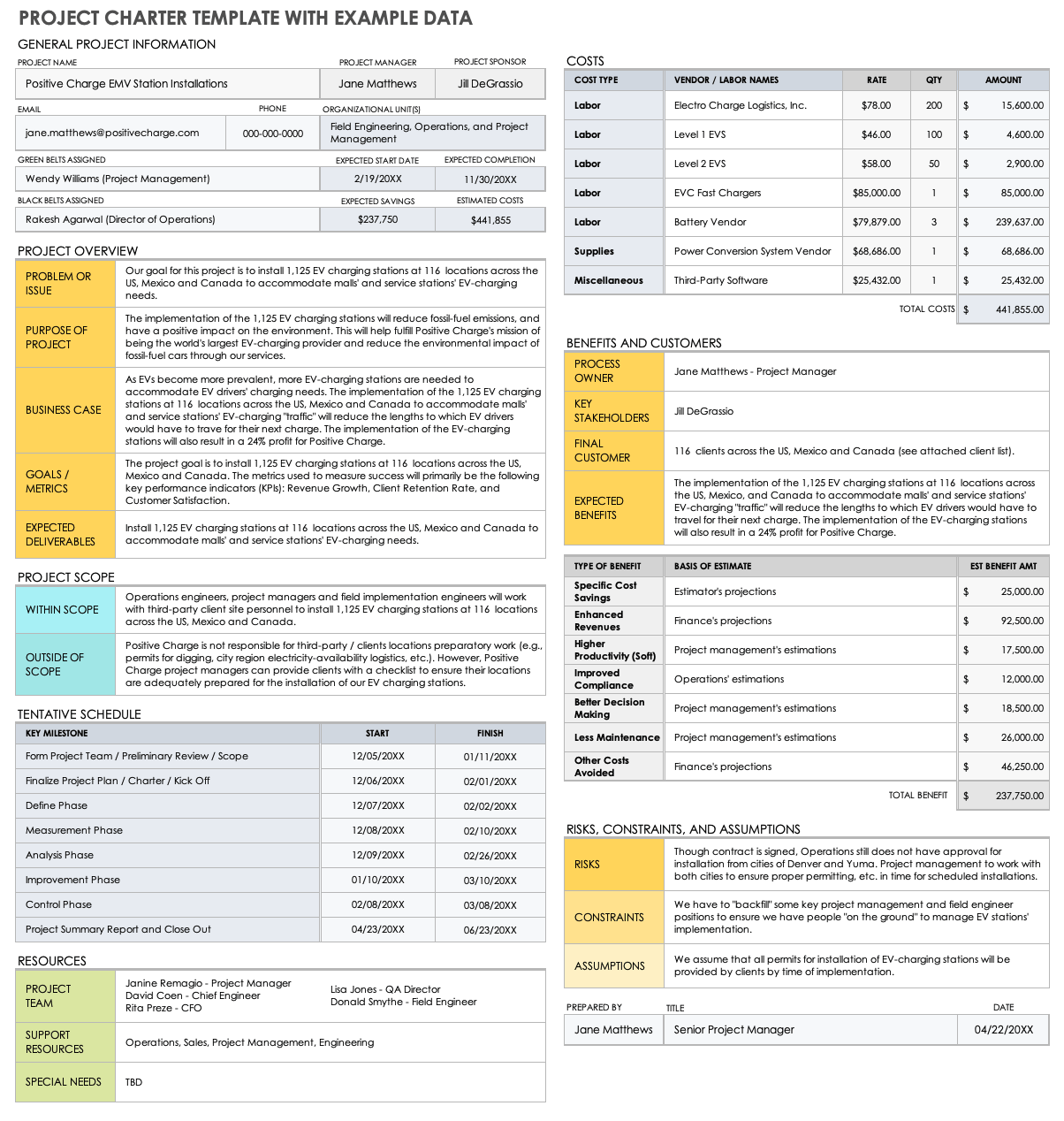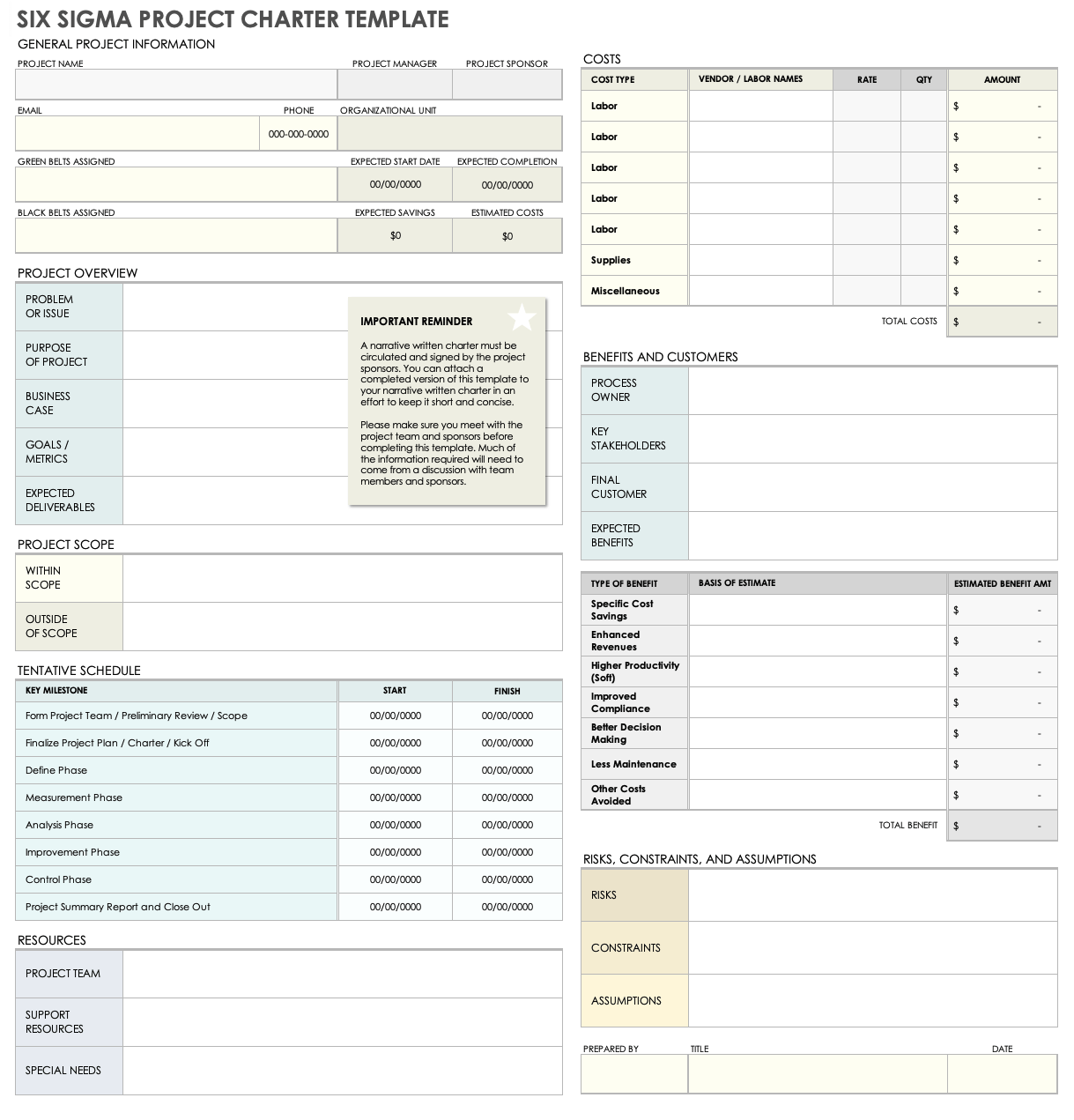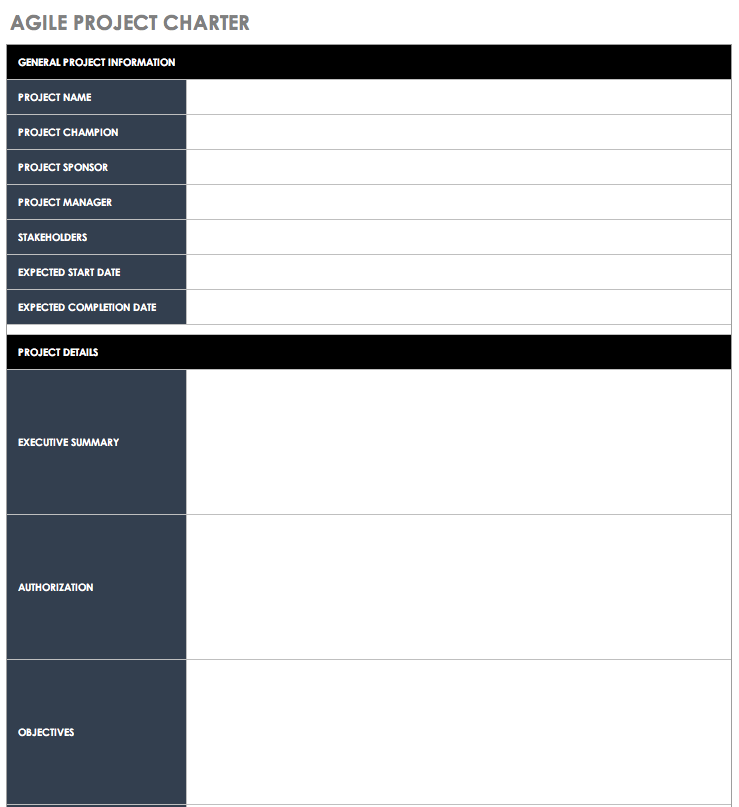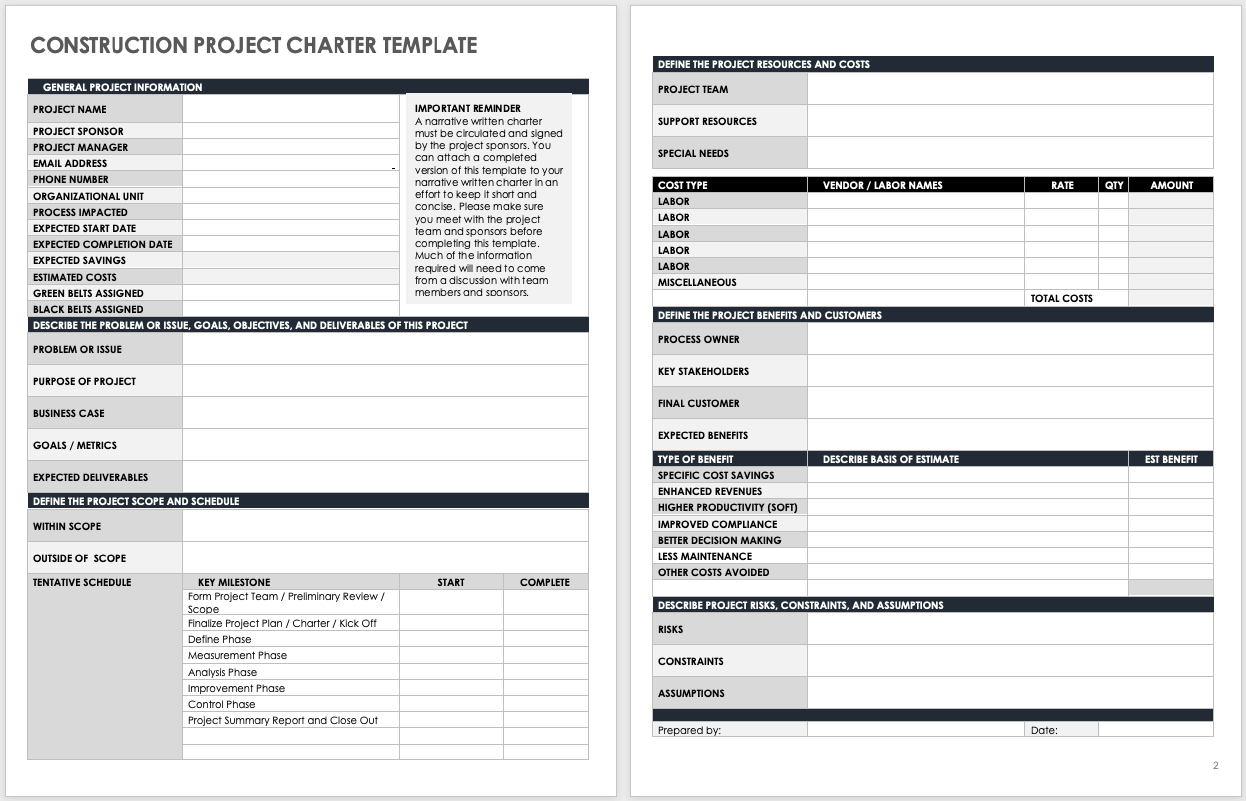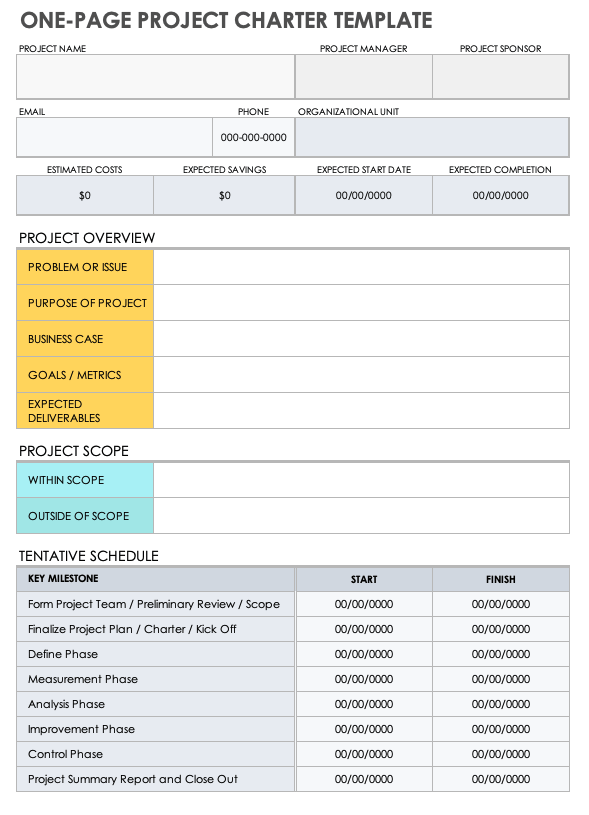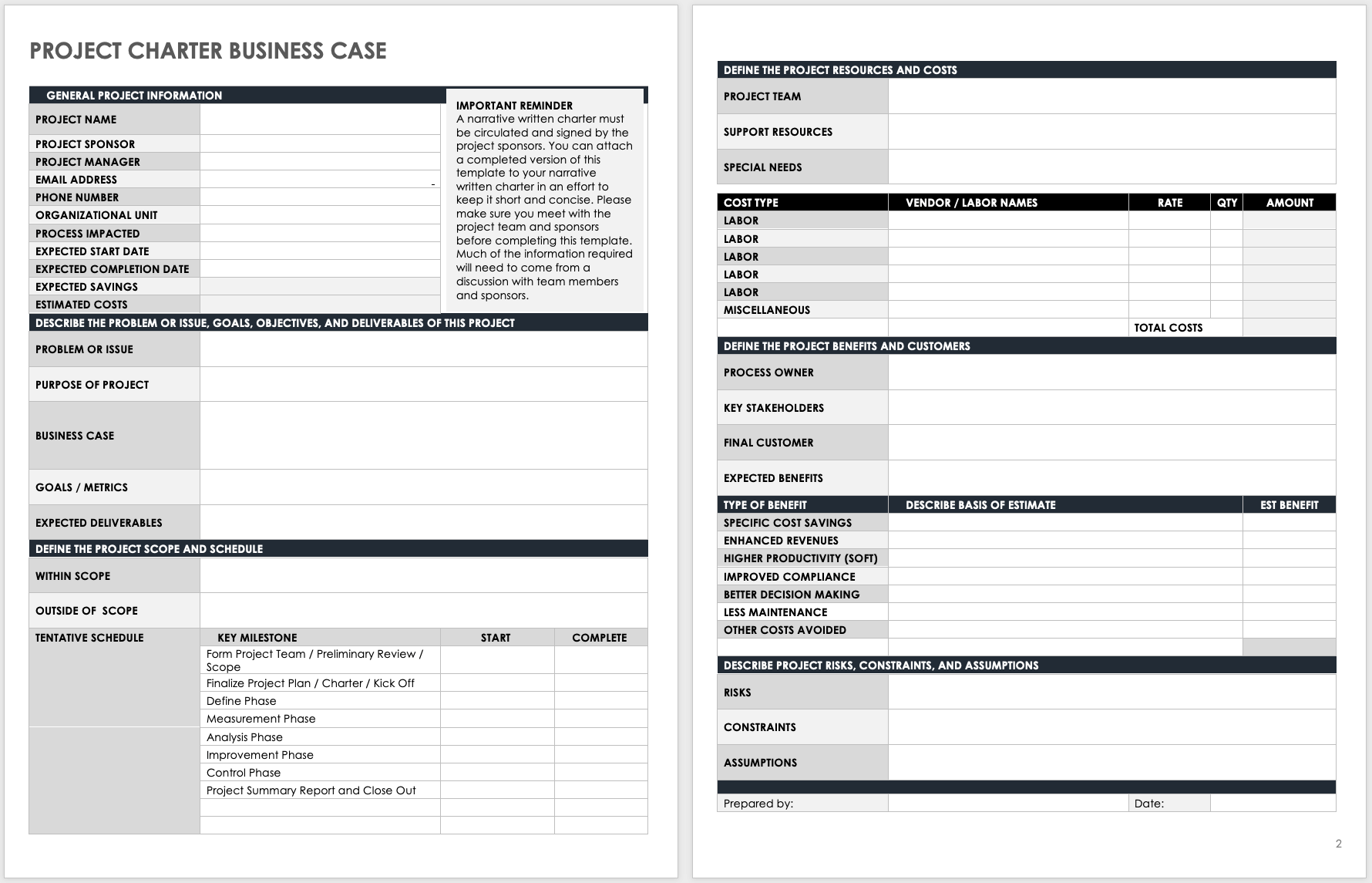Project Charter Template
Download Project Charter Template with Example Data
Excel
|
Microsoft Word
|
PowerPoint
| Google Docs | Smartsheet
Download a blank Project Charter Template for
Excel
|
Microsoft Word
|
PowerPoint
| Google Docs | Smartsheet
Use this easy-to-fill, comprehensive project charter template to standardize your project charter creation process. The template has various sections where you can provide general project details. In the Project Overview section, specify the problem(s) that the project aims to solve, as well as its purpose, business case, goals, metrics, and expected deliverables. In the remaining sections, elaborate on your project scope, tentative schedule, resources, costs, benefits, customers, risks, constraints, and assumptions.
For more resources and information, see this comprehensive guide to writing an effective project charter.
Project management that adapts to your needs
Work with flexibility and security—from small projects to large-scale processes and entire portfolios.
Smartsheet empowers teams to manage projects of any size by breaking them down into tasks, tracking dependencies, and visualizing progress. With tools for resource management, budget tracking, and workflow automation, you can ensure efficient project delivery.
The platform also provides real-time dashboards and reporting for better decision-making, helping you scale projects into programs seamlessly. Collaborate with your team on one unified platform to plan, manage, and execute projects successfully.
Six Sigma Project Charter Template
Download a Six Sigma Project Charter Template for
Excel
|
Microsoft Word
|
PowerPoint
Improve the quality and success rates of your projects with this Six Sigma project charter template. The template comes pre-filled with Six Sigma belt-level assignees (e.g., “Green Belts Assigned,” etc.), and helps ensure that you minimize waste, reduce costs, and enhance your competitive market position. With this all-inclusive template, you can define your project's scope, establish a proposed schedule, assign resources, list project costs, and define any potential risks, constraints, and assumptions. By utilizing this template, you can improve your project's performance and deliverables.
To find more resources on applying the Six Sigma method to your project charters, read this article on Six Sigma project chartering.
Agile Project Charter Template
Download an Agile Project Charter Template for
Excel
|
Microsoft Word
|
PowerPoint
This Agile project charter template covers the fundamentals for successfully planning and executing iterative software projects. The template includes the fundamental components of an Agile project, such as the project champion, project sponsor, stakeholders, start and end dates, and more. In summary, this Agile project charter template is an excellent resource for project managers and Scrum masters looking to plan deliverables for a software project effectively and efficiently.
If you want to learn more about clarifying your project vision with Agile methodology, see this comprehensive guide to creating Agile project charters.
Construction Project Charter Template
Download a Construction Project Charter Template for
Excel
|
Microsoft Word
|
PDF
Customize your construction project charter with this easy-to-use template. Start by defining all of the proposed features for your project, including your project purpose, problem statement, business case, goals, success metrics, and expected deliverables. Next, define the project's scope, tentative schedule, and key milestones. Finally, use the Cost Type section to itemize labor rates, quantity, and line-by-line total amounts. By using this template, you can effectively plan and manage your construction project, ensure that all key information is captured in a clear and concise manner, and clearly communicate your project's objectives, scope, and budget to stakeholders.
One-Page Project Charter Template
Download a One-Page Project Charter Template for
Excel
|
Microsoft Word
|
PowerPoint
|
PDF
| Google Docs
Use this print-friendly, single-page project charter template to provide project sponsors and clients with a comprehensive project overview. Enter general project information, including the problem to be solved, goals, objectives, and deliverables. Then define the project scope, schedule, resources, and costs. Next, describe the project's benefits and highlight any assumptions, constraints, and potential risks in the Project Risks, Constraints, and Assumptions section. This helps stakeholders understand the project's objectives, resources needed, and potential challenges.
Read this guide to the basic elements of project charters to find tips for improving your project charters.
Project Charter Business Case Template
Download a Project Charter Business Case Template for
Excel
|
Microsoft Word
Project managers need to create a detailed document that provides the business case in order to get official stakeholder approval. Use this template to define the project goals, benefits, and deliverables, list the process owners, and describe the project scope. This template is the perfect fit for teams who need an all-encompassing method to specify project specifications and resources.
For additional options, check out this collection of free business case templates.
What Is a Project Charter?
A project charter is an overview of a project that can also act as a business case. PMI® states that project charters organize and document a project's needs and expected outcomes in their PMBOK® Guide.
This resource lays the foundation for making project decisions that align with company goals. It should include success metrics, key players, goals, and a plan to accomplish the project. It's crucial to collaborate with team members to define these attributes before starting the project.
What Is a Project Charter Template?
A project charter template is a tool for defining project objectives, scope, and the required resources. Project managers can use a project charter template to outline the project in order to receive buy-in and approval from stakeholders.
Teams can also use a project charter template to strategize the best methods for successfully completing a project. It ensures that all project details, such as costs, purpose, metrics, deliverables, and the problem being addressed, are considered. The template facilitates the creation of a tentative schedule and key project milestones.
Key Project Charter Components
A project charter serves as a roadmap for the project team by outlining its purpose, goals, and scope. Key components to include in your project charter are project objectives, stakeholders, risks, constraints, and assumptions.
A successful project charter will typically include the following components:
- Project Name and Description: Provide a clear, concise title for the project, followed by a brief description of what it will entail.
- Project Purpose and Justification: Explain why the project is necessary and how it aligns with your organization's strategic goals and objectives. For example, you might include relevant market, customer, or business needs that the project aims to fulfill.
- Project Objectives: List the project’s objectives. These should be quantifiable results that will signal the project's success.
Follow the SMART goal-writing framework to create the most effective objectives for your project charter. - Project Scope: Clearly define the project's scope by outlining what is included and what is not included in the project.
- Stakeholders and Roles: Identify and define the roles and responsibilities of key stakeholders, such as project managers, sponsors, team members, and relevant departments, to ensure clear communication and coordination throughout the project.
- Project Deliverables: Specify the project deliverables, including products, services, and documentation, with as much detail as possible regarding their features, functionality, and attributes.
- Project Timeline: Create a project schedule that outlines start and end dates, key milestones, deadlines, and any dependencies that could affect the timeline. Ensure the schedule is high level but comprehensive.
- Project Budget: Specify the estimated project budget, including costs for resources, materials, and expenses, and identify any assumptions or constraints related to the project's budget.
- Project Risks and Constraints: Identify and propose strategies for managing potential project risks and constraints.
- Project Assumptions: Include a list of assumptions made during the development of the project charter. These could pertain to the availability of resources, stakeholder capacity, or other variables that may influence the project.
- Approval and Signatures: Obtain formal approval and signatures from the project sponsor(s) and key stakeholders to authorize the project.
- Prepared By: Record the name and completion date of the team member who prepared the project charter.
A comprehensive project charter serves as a solid foundation for successful project implementation and stakeholder alignment. Keep it accessible and up to date as the project progresses, referring back to it throughout the project lifecycle to guide decision-making
How to Create a Project Charter
In order to create a project charter, first define the project’s purpose, goals, and scope. Next, provide more details on the project, including stakeholder responsibilities, deliverables, budget information, risks and constraints, and approvals.
Here are step-by-step instructions for creating your own project charter:
- Define the Project: First, identify the purpose and objectives of the project. What problem does the project aim to solve? What are the desired outcomes? Be specific to ensure that your project’s objectives are measurable and achievable.
- Identify the Stakeholders: Identify all stakeholders who will be impacted by the project, both internal and external. This includes team members, sponsors, customers, vendors, and others who have an interest in your project.
- Determine the Project Scope: Define your project’s boundaries, including what is included and what is not. Specifying what is in scope and out of scope for the project will help you manage expectations and avoid scope creep.
- Develop a Project Schedule: Create a high-level timeline for your project, which includes key milestones and deadlines. This will help to keep the project on track and ensure that everyone is working toward the same goal.
- Determine the Budget: Estimate the project’s associated costs, including labor, materials, and other expenses. This will help to ensure that your project is financially feasible and that resources are efficiently allocated.
- Assign Roles and Responsibilities: Define the roles and responsibilities of all stakeholders, including the project manager, sponsor, and team members. This will help to ensure that everyone knows what is expected of them and can work successfully together.
- Identify Risks: Identify any potential risks to your project, and develop a plan to mitigate those risks. This will help to minimize the impact of any unexpected events on the project.
- Obtain Approval: Once your project charter is complete, obtain formal approval from all stakeholders.
By following these steps, you can create a comprehensive project charter that will help to ensure your project’s success.
Benefits of Using a Project Charter
An effective project charter clarifies stakeholder roles and responsibilities, prevents scope creep, and aligns team members on expectations and goals. In short, a project charter provides a clear roadmap that helps ensure a project’s success.
These are some key benefits of using a project charter:
- Provides a Clear Vision: A project charter defines a project's purpose, goals, and objectives, creating a clear vision for the team to follow. This ensures shared goals and minimizes confusion among team members.
- Defines Project Scope: A project charter outlines the project's scope, defining what is included and what is not. This helps prevent scope creep, which can lead to delays and increased costs.
- Encourages Collaboration Between Stakeholders: A project charter lists all internal and external stakeholders involved in the project, ensuring their inclusion in the planning and implementation processes. This in turn increases collaboration, communication, and accountability.
- Manages Expectations: A project charter clearly defines the project's objectives, scope, and timelines. In this way, it helps manage stakeholders’ expectations.
- Minimizes Risks: A project charter includes all identified risks and outlines a plan to mitigate them, allowing team members to anticipate roadblocks and minimize the impact of unexpected events on the project.
Provides a Decision-Making Framework: A project charter provides a framework for making project decisions, helping the project team make informed choices that align with the project's objectives and goals.
Get the Most out of Your Project Charter with Smartsheet for Project Management
From simple task management and project planning to complex resource and portfolio management, Smartsheet helps you improve collaboration and increase work velocity -- empowering you to get more done.
The Smartsheet platform makes it easy to plan, capture, manage, and report on work from anywhere, helping your team be more effective and get more done. Report on key metrics and get real-time visibility into work as it happens with roll-up reports, dashboards, and automated workflows built to keep your team connected and informed.
When teams have clarity into the work getting done, there’s no telling how much more they can accomplish in the same amount of time. Try Smartsheet for free, today.
